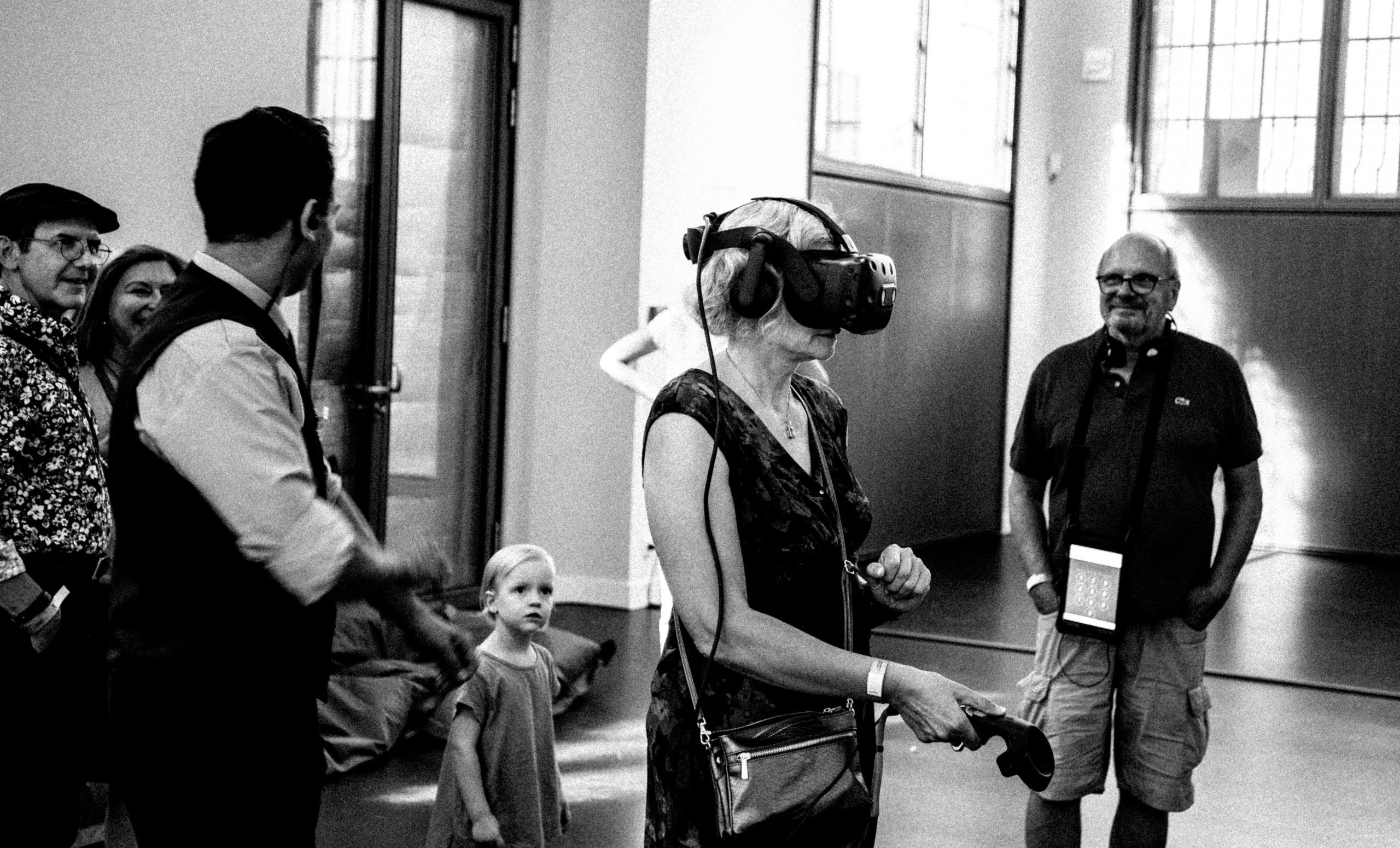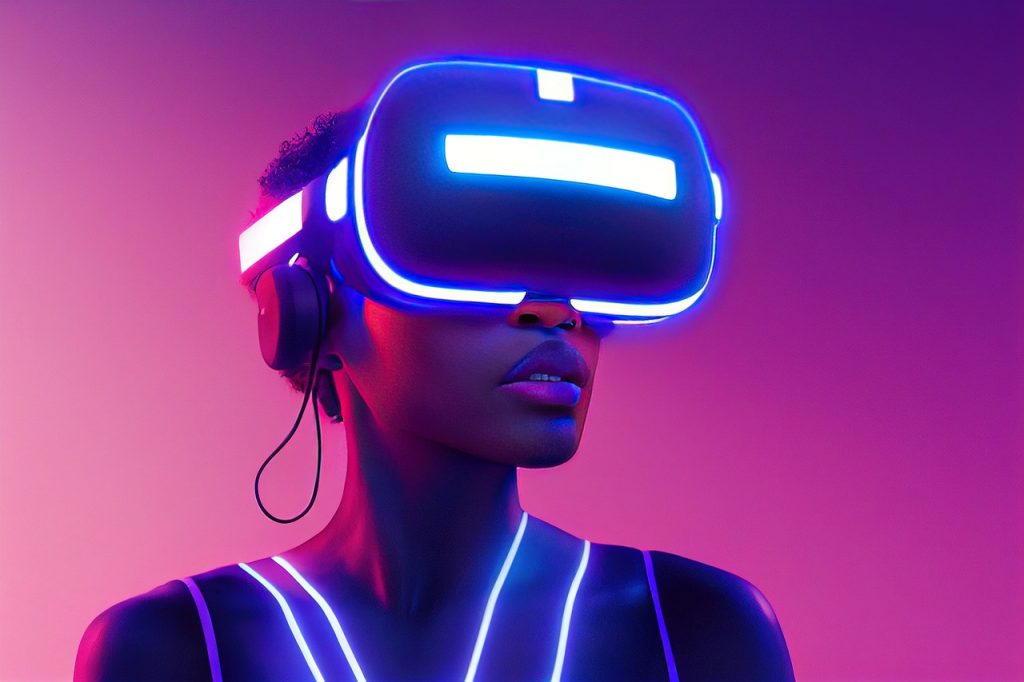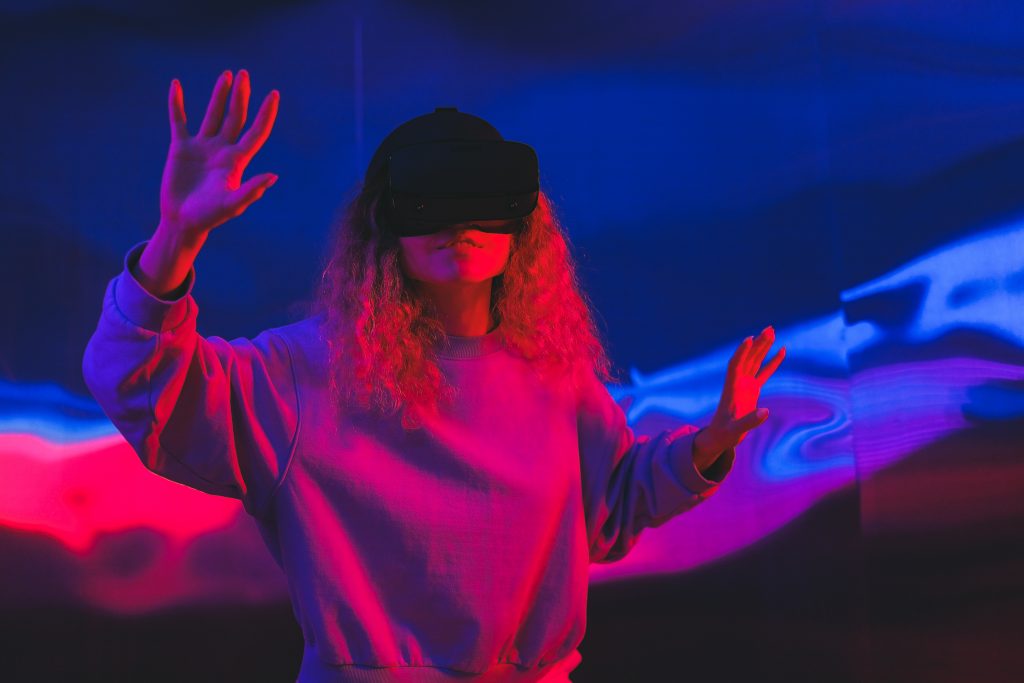Gender in extended reality
Kate Euphemia Clark, Marcus Carter and Ben Egliston

Gender-based discrimination in mixed reality is a pernicious problem, both at the level of experiencing gameplay, and more deeply at the level of the technology itself. This will only become more pervasive as metaverse products become more entwined in our work and social lives.
Sexual harassment in virtual spaces has unfortunately had a long history in XR technologies. One of the most prominent early pieces of writing in this vein is Belamire’s (2016) blog post outlining her experience of sexual assault in the form of “virtual groping” in social VR archery game QuiVr (2016), describing the experience as something that was very real in terms of its felt effects. Belamire’s experience, as a survey of VR users’ social experiences (Outlaw and Duckles, 2018) points out, is not uncommon. For surveyed users of VR in 2018, 49% of female and 36% of male respondents reported experiencing some form of sexual harassment.
More recently, in Meta’s HorizonWorlds VR space, a female beta tester was groped in a sexually explicit manner (BBC 2021). This raises some serious concerns that the safety of these digital spaces have not been improved since 2016. Meta responded by both suggesting that the user should have better utilised Meta’s safety features (Heath 2021), and by suggesting that we would not hold the owner of a bar responsible for a similar incident in their space (Clegg 2022) in an attempt to downplay Meta’s responsibility in these situations. Clegg argues “we wouldn’t hold a bar manager responsible for real-time speech moderation in their bar, as if they should stand over your table, listen intently to your conversation, and silence you if they hear things they don’t like”. However, as Kate Clark and Trang Le suggest, it is disingenuous to equate the metaverse to managing a real-life bar, as public spaces within the metaverse sit between digital spaces and real-life spaces, and therefore need to be moderated differently to both physical spaces and other, flatscreen digital spaces (2022).
Global Non-profit advocacy group SumOfUs, that campaigns to hold corporations accountable for their role in issues such as climate change, human rights, discrimination, and corruption, reported that a researcher was in HorizonWorlds for less than an hour before she experienced sexual assault on the platform, with one user simulating sex with her avatar, while another user watched, drank a bottle of vodka. They then gave her the bottle, saying: “here you’re going to need more of this” (SumOfUs 2022).

The researcher recalled that, “it happened so fast I kind of disassociated” (SumOfUs 2022). The SumOfUs report features a number of other disturbing cases of sexual assault that happened alarmingly quickly after the user entered the virtual spaces. It is also important to note that this kind of harassment is not exclusive to women, reporters recently tested Meta’s moderation policy by building a room based on the right-wing conspiracy theory known as Qanon, and found that despite reporting the world three separate times, Meta had found that it did not violate its content or conduct policies (Baker-White 2022).
Describing her sexual assault in 2016, Belamire notes “The virtual groping feels just as real. Of course, you’re not physically being touched… but it’s still scary as hell” (2016, n.p.). The account Belamire provides is reminiscent of earlier observations about virtual harassment, specifically, Dibbell’s well-known article A Rape in Cyberspace (1993) in which a user, expert in the affordances of a text-based virtual environment, non-consensually mediated sexual encounters between other players and themselves – something no less harmful despite there being “no bodies touched” (Dibbell,1993, n.p.).
As Trang Le highlights, in part the reason that sexual assault in digital spaces feels so confronting is because it is representative of larger patriarchal structures that condone male violence towards women in all spaces (Le, 2022). Le uses Liz Kelley’s continuum of sexual violence to describe how digital sexual violence must be understood within the broader context sexual violence outside the digital world (2022, np). This is compounded by the fact that VR based sexual harassment, Belamire (2016) outlines, is particularly problematic due to how VR affords the user an immersive, auditorily and visually rich experience – something that is often framed as a key, positive characteristic of the medium. What, then, can be done to redress these forms of mediated harassment?
Following Belamire’s 2016 assault and article about the incident, QuiVR’s developers responded by providing users more power over their (virtual) personal space, writing that “If VR has the power to have lasting positive impact because of that realism, the opposite has to be taken seriously as well” (Jackson and Schenker, 2016, n.p.). They discuss changes made to QuiVr following the publication of Belamire’s account, such as including a ‘personal bubble’ feature that means that other players ‘fade out’ when they reach to grab or touch another. This has been adopted in relatively few games. However, Meta has adopted the personal bubble on its platform to address these concerns, where only people on a user’s friend list can step inside their bubble (Clegg 2022).
However, this does not adequately address a broader range of ‘creepy’ behaviour in VR spaces that does not necessarily require proximity. As tech reporter Parmy Olson notes, when she entered Horizon Worlds, she was the only person with a female-presenting avatar, to which she states: “I had these men kind of come around me and stare at me silently … Then they started taking pictures of me and giving the pictures to me and I had a moment when a guy zoomed up to me and said something. And in virtual reality, if someone is close to you, then the voice sounds like someone is literally talking into your ear. And it took me aback” (Wakefield 2022). The placement of speakers close to the head in commercial VR headsets can make it feel as though people are much closer than they appear to be, which raises questions of how we conceptualise distance and harassment. This is not adequately addressed by the personal boundary alone.
Katherine Cross has suggested we take seriously VR based sexual harassment as a form of sexual harassment, arguing “the mediating interface of a game does not make abusive behaviour between two or more real people any less abusive. Slurs are still slurs; unwanted sexual advances are still both unwanted and sexual” (Cross 2016). Despite this, as Cross notes, responses to VR harassment tend to downplay its severity due to its digital setting and place the onus on the victim to end the experience, suggesting “she could easily turn off, or just ‘take off her headset’ to escape” (2016). This seems to be Meta’s position as well, as they have suggested that the instances of sexual assault in the metaverse was because the victims did not have their personal boundary enabled (Heath 2021), which has echoes of other ways that violence against women has historically been downplayed.
“[r]esponses to VR harassment tend to downplay its severity due to its digital setting and place the onus on the victim to end the experience.”
Several works have since further explored how virtual harassment does have the potential for real harm. Murphy (2017) suggests that VR is a medium through which “the player’s body is a meaningful and easily-accessible site for delivering feedback” (2017, p.14), and as such, proxemic effects “are perceptually and cognitively analogous to real-world vision and audition. For emphasis, it is worth restating that virtual humans standing too close to VR users can be experienced as uncomfortable or distressing” (2017, p.14). From a legal perspective, Danaher (2018) works through various definitions of what constitutes assault, applying this to think about VR, ultimately concluding that harassment in VR can constitute sexual assault. Danaher flags that VR poses issues surrounding consent and recommends creating clear and unambiguous forms of signalling consent. For Wood et al. (2017) the issue of clearly signalling consent in VR is further echoed. In addition, they also suggest that VR represents an intensification of existing issues with sexual harassment and technology (e.g. the creation of VR based digital representations of bodies, continuing the problematic tend of deepfakes).
For Blackwell et al. (2019), drawing from survey and interview research, harassment and discomfort is prevalent in social VR experiences. They suggest that rife harassment might stem from both VR’s entanglement with masculinised and often toxic ‘gamer’ culture and the interactive and immersive nature of VR itself. It’s worth noting, as Blackwell et al. do in their limitations, that their study was unable to recruit more women and nonbinary users into their sample, and as such deals largely with the experiences of cis male users. Despite limitations, they provide a useful framework for thinking about different kinds of VR mediated harassment – paying attention to the specific affordances of the VR medium (see Blackwell et al., 2019, p. 12). These are: 1) verbal harassment (personalised insults, such as hate speech or sexualised language, transmitted through VoIP or private messages), 2) physical harassment (such as unwanted touching or making visible sexual gestures, signalled through the movement of one’s avatar), and 3) environmental harassment (displaying sexual or violent content in the virtual environment, such as creating and sharing sexually explicit virtual drawings). Blackwell et al.’s (2019) account is increasing relevance given its specific focus on harassment within social VR which is increasingly the focus of companies like Meta.
So far, we have focused largely on sexual harassment to do with interactions between human users. Offering a different perspective, Franks (2017) outlines how engagements with non-player characters in VR spaces might also be cast as problematic and contributing to an affirmation of sexual harassment in VR, giving the example of the game Dead or Alive Xtreme 3 on Playstation 4’s VR – which allows players to grope the game’s bikini clad non-player characters while she grimaces, protects her body with her arms, and says “I don’t like it”. In the video demo shared online that precipitated media attention, the male-sounding audience laughs in response. As Franks writes “The primary concern with games like these is not the harm one user inflicts on another actual user in a virtual reality environment, but the harmful habits the technology encourages the user to indulge” (2017, p.528). As Buckley (2016) puts it, Dead or Alive Xtreme 3 is “basically sexual assault the game” (n.p.), and the dedicated VR ‘porn games’ is a growing genre, with many depicting – or focusing on – sexual assault fantasies.

Beyond sexual harassment, there are other issues to do with gender and the design of accessible VR experiences. Stanney et al (2020) explored the gendered nature of cybersickness in the Oculus. They found that interpupillary distance (IPD) was a core factor in motion sickness, and that women were significantly more likely to be unable to fit their IPD to the VR headset (Stanney et al 2020). These findings follow many personal accounts from women.
As boyd (2014) provocatively asks, “is the Oculus Rift sexist?” – describing the physical side effects of nausea felt by herself and other female colleagues in using Oculus’s VR. She suggests that the cause is humans using ‘depth cues’ to determine how far away objects are.
boyd elaborates, noting that there are two main kinds of cues, ‘motion parallax (which tells the brain if an object is getting larger it is also getting closer) and ‘shape-from-shading’ (which gives the brain a sense of an object’s distance due to the way light is cast on an object). Crucially, boyd argues, as motion parallax is easier to replicate, VR systems primarily rely on motion parallax cues. The problem with this, as boyd notes, is that men tend to prioritise motion parallax cues while women rely more on shape-from-shading. These key physiological differences in gender have not been taken into account in the design process resulting in issues of accessibility – a case highlighting the importance of incorporating a more diverse range of perspectives into the design of VR (and technology more broadly).
More recent empirical work has found that women are at greater risk of motion sickness from VR (Munafo et al. 2017), which has significant consequences in terms of access and inclusion as VR becomes more widely available and used in contexts like education, training and employment, and that women are underrepresented as participants in VR user studies and as authors of VR research (Peck et al. 2020).
Scoping out, there are wider structural issues that clearly point to this culture of toxicity and sexism around VR. As Blackwell et al. (2019) and Harley (2019) point out, VR’s emergence can be situated within a milieu of misogynistic videogame culture and reactionary right political views – views famously held by Oculus founder Palmer Luckey. In such a way, VR as conceived by Luckey is taken to represent freedom and autonomy – something that has benefits for cis-male users like Luckey, but not for the female users against which the technology is weaponised.
References
Baker-White, E (2022). Meta wouldn’t tell us how it enforces its rules in VR, so we ran a test to find out. Retrieved from https://www.buzzfeednews.com/article/emilybakerwhite/meta-facebook-horizon-vr-content-rules-test
BBC (2022). ‘Female avatar sexually assaulted in VR platform’. Retrieved from https://www.bbc.com/news/technology-61573661
Belamire, J. (2016). My first virtual reality groping. Retrieved from https://medium.com/athena-talks/my-first-virtual-reality-sexual-assault-2330410b62ee
Blackwell, L., Ellison, N., Elliott-Deflo, N. & Schwartz, R. (2019). Harassment in social virtual reality: Challenges for platform governance. In Proceedings of ACM Human-Computer Interaction (pp. 1–25). New York, NY: ACM.
boyd, d. (2014). ‘Is the Oculus Rift sexist?. Retrievied from https://qz.com/192874/is-the-oculus-rift-designed-to-be-sexist/.
Buckley, S. (2016). ‘Dead or Alive’ VR is basically sexual assault, the game. Retrieved from https://www.engadget.com/2016-08-29-dead-or-alive-vr-is-basically-sexual-assault-the-game.html
Clark, K.E. and Le, T (2022). Sexaual assault in the metaverse isn’t a glitch that can be fixed. Retrieved from https://lens.monash.edu/@politics-society/2022/10/13/1385033/sexual-assault-in-the-metaverse-isnt-a-glitch-that-can-be-fixed.
Clegg, N. (2022). Making the metaverse: what it is, how it will be built and why it matters. Retrieved from https://nickclegg.medium.com/making-the-metaverse-what-it-is-how-it-will-be-built-and-why-it-matters-3710f7570b04
Cross, K. (2016). Sexual assault enters virtual reality. Retrieved from https://theconversation.com/sexual-assault-enters-virtual-reality-67971
Danaher, J. (2018). The law and ethics of virtual sexual assault. In Barfield, W. & Blitz, J.M. (Eds), Research handbook on the law of virtual and augmented reality (pp. 363–388). Cheltenham, UK: Edward Elgar Publishing.
Dibbell, J. (1993). A rape in cyberspace. Retrieved from http://www.juliandibbell.com/texts/bungle_vv.html
Franks, M.A. (2017). The desert of the unreal: Inequality in virtual and augmented reality. UC Davis Law Review, 51, 499–538
Harley, D. (2019). Palmer Luckey and the rise of contemporary virtual reality. Convergence. Advance online publication. doi: 10.1177/1354856519860237
Heath, Alex. (2021). Meta opens up access to its VR social platform Horizon Worlds. Retrieved from https://www.theverge.com/2021/12/9/22825139/meta-horizon-worlds-access-open-metaverse
Jackson, H. & Schenker, J. (2016). Dealing with harassment in VR. Retrieved from https://uploadvr.com/dealing-with-harassment-in-vr/
Le, Trang. (2022). Sexual assault in the metaverse is part of a bigger problem that technology alone won’t solve. Retrieved from https://lens.monash.edu/@trang-le/2022/07/22/1384871/sexual-assault-in-the-metaverse-theres-nothing-virtual-about-it
Munafo, J., Diedrick, M. & Stoffregen, T. A. (2017). The virtual reality head-mounted display Oculus Rift induces motion sickness and is sexist in its effects. Experimental brain research, 235(3), 889–901.
Murphy, D. (2017). Virtual reality is ‘finally here’: A qualitative exploration of formal determinants of player experience in VR. DiGRA ’17 – proceedings of the 2017 DIGRA International Conference, 1(14), 1–20.
Outlaw, J. & Duckles, B. (2018). Virtual harassment: The social experience of 600+ regular virtual reality (VR) users. Retrieved from https://extendedmind.io/blog/2018/4/4/virtual-harassment-the-social-experience-of-600-regular-virtual-reality-vrusers
Peck, T. C., Sockol, L. E. & Hancock, S. M. (2020). Mind the Gap: The Underrepresentation of Female Participants and Authors in Virtual Reality Research. IEEE Transactions on Visualization and Computer Graphics, 26(5), 1945–1954.
SumOfUs (2002). Metaverse: Another cesspool of toxic content. Retrieved from https://www.sumofus.org/images/Metaverse_report_May_2022.pdf.
Stanney, K., Fidopiastis, C., & Foster, L. (2020). Virtual reality is sexist: but it does not have to be. Frontiers in Robotics and AI, 7, 4.
Wakefield, J. (2022). Meta moves to tackle creepy behaviour in virtual reality. Retrieved from https://www.bbc.com/news/technology-60247542Wood, M., Wood, G. & Balaam, M. (2017). “They’re just tixel pits, man”: Disputing the ‘reality’ of virtual reality pornography through the story completion method. In Proceedings of the 2017 CHI Conference on Human Factors in Computing Systems (pp. 5439–5451). New York, NY: ACM. https://doi.org/10.1145/3025453.3025762
Recommended citation
Clark, K.E., Carter, M, and Egliston, B. (November, 2022) Gender and extended reality. Critical Augmented and Virtual Reality Researchers Network (CAVRN). https://cavrn.org/gender-and-accessibility-in-extended-reality/
An earlier version of this literature review was published for the Socio-Tech Futures Lab in 2020. This version has been updated to include more recent literature.
This work is licensed under a Creative Commons Attribution-NonCommercial-NoDerivatives 4.0 International License.
